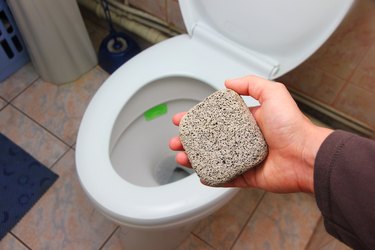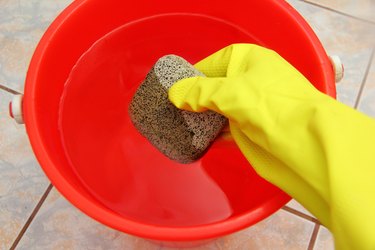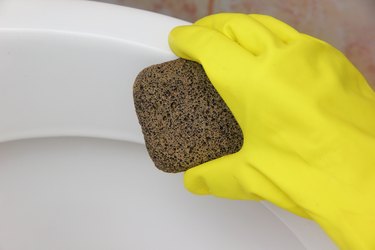
The already unpleasant job of cleaning a toilet becomes even worse when, despite your best efforts, you can't get out stubborn stains, mineral buildups and rings at the water line. If the toilet is porcelain, reach for a pumice stone or stick, an inexpensive yet very effective cleaning tool that requires no chemical cleaning products -- only water and some scrubbing action. While impressive in its efficacy, a pumice stone isn't suitable for cleaning the toilet on a regular basis; reserve the task only for infrequent deep-cleaning sessions.
About Pumice Stones
Video of the Day

Pumice, a volcanic rock, is a very soft, light and porous stone. Stones and bar-shaped sticks are sold on the cleaning aisles of supermarkets and hardware stores; some have a plastic handle attached. They are relatively inexpensive, but wear down with use and must be replaced. A pumice stone is effective for cleaning porcelain toilets without scratching them because the stone is harder than most mineral deposits and stains that typically develop on toilets, yet softer than porcelain. As you scrub porcelain with a pumice stone, the stone wears away and leaves small particles of pumice dust on the wet surface. This dust combines with water to form an abrasive paste. As you continue to scrub, the paste and the rough pumice stone combine to form a two-fold strike against stains.
Video of the Day
Clean With a Pumice Stone

Before cleaning a porcelain toilet with a pumice stone, you must thoroughly wet both the stone and the surface to be cleaned and keep the stone and the surface wet as you work. Wear rubber gloves and use the toilet water for this purpose, or keep a separate bucket of clean water beside you. Scrub stains and marks directly with the stone, applying firm, even pressure in a circular or back-and-forth motion. You'll see gray residue develop on the surface of the porcelain, which is the paste formed from the worn-away pumice and water. Don't rinse the paste away immediately; instead, continue to scrub the toilet with the paste. Rinse the surface with clean water after every few minutes of scrubbing to assess how much progress you've made on the stains. Move on to the next area as soon as the previous one looks clean. Remember to wet the stone and porcelain frequently as you work. Flush the toilet to rinse away all the residue from the bowl when you have finished.
Pumice Stone Cleaning Tips

Alternate the angle of pressure as you scrub the toilet with a pumice stone. As the stone wears away, you create a point or flattened area that conforms to the rounded shape of the toilet bowl and makes for a more effective scrubbing action. Wear the end of a stick-shaped pumice stone into a thick pen- or chisel-like shape for easy cleaning.
In addition to cleaning toilets, pumice stones can also be used on other hard surfaces, such as porcelain bathtubs, tiles, oven racks and rusted metal tools. Check the packaging of your pumice stone for the manufacturer's recommendations.
Warnings

Do not use pumice stones to clean marble, laminate, plastic or fiberglass toilets; doing so will result in permanent scratches. A dry pumice stone will also scratch porcelain, so be sure to keep the stone and the toilet surface wet at all times. Also bear in mind that even if you have a porcelain toilet, the toilet seat is more likely to be plastic and should not be scrubbed with a pumice stone. If you are not sure what your toilet is made of, test the pumice in an inconspicuous area before proceeding.